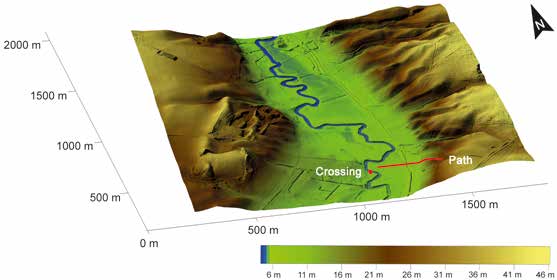An early Bronze Age causeway in the Tollense Valley, Mecklenburg-Western Pomerania – The starting point of a violent conflict 3300 years ago?, by Jantzen et al. (BERICHT RGK 95, 2014).
Excerpt (emphasis mine):
The causeway in the Tollense Valley, built of timber, stones, turf and sand, and documented over a length of more than 100 m, represents a unique finding from northern Germany. For the first time, part of a Bronze Age network of land routes could be made visible in the southern Baltic area.
Together with the other evidence, the archaeological remains suggest the construction of elaborate trackways and, in some cases, even bridges in the Bronze Age. The Tollense Valley causeway can probably be attributed to the wish or the necessity to be able to cross the Tollense Valley regardless of weather and seasonally differing water level conditions. Its location, situated at a narrow section of the Tollense Valley, offered a prime position for the construction of a permanent crossing of the floodplain on the eastern bank. It is quite possible that a bridge was also part of this.
The complex causeway construction that was likely used and maintained for centuries suggests a significance of the crossing beyond just local. In this context, finds from the valley relating to Bronze Age metal crafts are of interest: along with the scrap metal hoard mentioned above found in the immediate area of the crossing, attention is drawn to a hoard from Golchen comprising an unusual accumulation of tools, as well as to two tin rings found in the same archaeological layer as the Bronze Age skeletal remains. These finds could indicate that metal crafts were of particular significance in the Tollense Valley and its surrounding areas. The middle section of the Tollense Valley that is the focus of attention here could have derived special significance from its role as a crossroads.
The documented pathway, which may have been the starting point of the violent conflict described above, not only contributes to the understanding of the entire findings and the reconstruction of the events in the early 13th century BCE in the Tollense Valley; its context also sheds new light on the cross-regional infrastructure of North-East Germany in the (Early) Bronze Age. Unfortunately, there currently is little further information to integrate it into the broader network of supraregional communication and traffic routes.
The region around the famous barrow of Seddin in Brandenburg is a further example for the significance of river systems for regional power and the exchange of goods. Similarly, the River Tollense could have played a role in the flow of commodities; the causeway at the Kessin 12 site offers a possible connection of the south-north water transportation route via the Tollense River to the Baltic Sea with an east-west land route linking the River Oder estuary region and the Mecklenburg Lake District.
The Lake District was of great importance from the Early Bronze Age; here independent bronze production was established early on. Diversity analyses indicate a shift of regions of innovation during the transition from the 3rd to the 2nd millennium BCE, as the southern Baltic Sea region and the region east of the river Oder clearly also became more important. Early Bronze Age imports from south-east Europe highlight the significance of the region west of the Oder estuary. The Tollense Valley likely played a role in connecting these areas. Therefore, the violent events in the Tollense Valley could also be seen as a result of its strategic significance for the power structure of North-East Germany and the regions on the southern Baltic coast during the Early Bronze Age.

See also:
- The Tollense Valley battlefield: the North European ‘Trojan war’ that hints to western Balto-Slavic origins
- Bell Beaker/early Late Neolithic (NOT Corded Ware/Battle Axe) identified as forming the Pre-Germanic community in Scandinavia
- mtDNA suggest original East Germanic population linked to Jutland Iron Age and Bell Beaker
- The Indo-European demic diffusion model, and the “R1b – Indo-European” association
- Our monograph on North-West Indo-European (first draft) is out